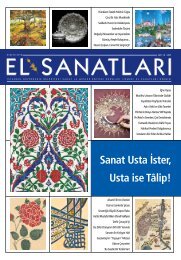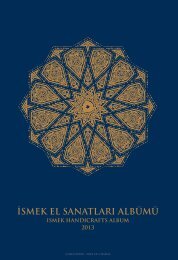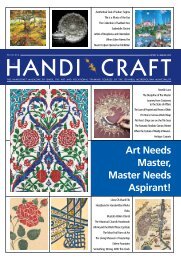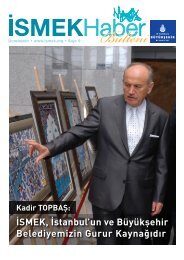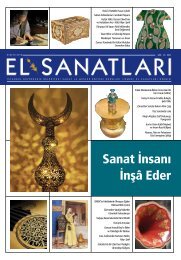Download Link - Ä°SMEK
Download Link - Ä°SMEK
Download Link - Ä°SMEK
You also want an ePaper? Increase the reach of your titles
YUMPU automatically turns print PDFs into web optimized ePapers that Google loves.
When you think of the Ottomans, the first word which comes into<br />
mind is splendor. An Empire which ruled over three continents,<br />
which has a reputation as the mightiest Turkish State has traces<br />
of splendor in all relics of the past. Historical buildings,<br />
palace furniture, Sultans’ personal belongings<br />
and many more…<br />
Glamorous clothing of the Sultans with fancy details<br />
reflects the splendor that comes from power. In order<br />
to represent the majesty of the Empire, Sultans were<br />
particular about their clothing and they preferred the<br />
best fabric. This promoted the textile industry in the Ottomans.<br />
The fabric for their clothing and upholstery was<br />
woven in palace workshops and designed meticulously<br />
by palace miniaturists. When these workshops were<br />
not enough, orders were placed to other workshops<br />
in Istanbul and Bursa. Silk texture was strictly controlled<br />
to make sure that the number of threads is<br />
adequate, the paint is proper and so on.<br />
As the Empire was getting larger and glorious, precious<br />
stones and furs were added to the quite simple<br />
clothing of the Sultans of the early times. Those caftans<br />
are preserved by special techniques. They can be greatly<br />
admired in the museums. Strikingly, they are very large<br />
in size. The reason behind the size was to add splendor<br />
to the fine art of Sultans’ clothing which had perfect weaving<br />
and the embroidering of the jewels.<br />
There were two kinds of caftans, one for the outer, and the<br />
other for the inner. The external caftans were for the ceremonies.<br />
Ceremonial caftans were woven with gold or silver<br />
threads. Both kinds of caftans were a little high-necked,<br />
unsealed on the front and slit at the sides.<br />
They had long or short sleeves and<br />
they had pockets. The ceremonial<br />
caftans had additional sleeves<br />
with the same length<br />
of the caftans. They added<br />
glamour to the appearance<br />
of the sultans<br />
and they had a<br />
historical function<br />
such as to be kissed<br />
by the subjects.



